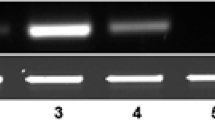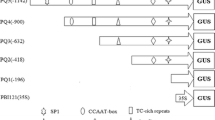Abstract
Mutations of the first position T and the third position G in TTGACA, the “- 35” element of sorghumpsbA gene promoter, were induced using chemically synthesized 20 nt oligonucleotide primer. Three mutants were produced: ATTACA, GTGACA, and ATGACA. Then the protein binding affinity of the mutants and the wild type sorghumpsbA gene promoter was tested in a spinach chloroplast protein extract system. Gel retardation assay of the wild type showed a strong protein-binding band. On the other hand, the protein-binding band of the mutant resulting from single base mutation, ATGACA or GTGACA, showed reduced intensity, while that of the mutant resulting from double base mutation, ATTACA, showed increased intensity. It is thus shown that the “- 35” element plays an important role in controlling the binding betweenpsbA gene promoter and the specific chloroplast proteins; mutation of a single base may exert a substantial influence on the binding affinity.
Similar content being viewed by others
References
Bowdoin, L. H., Chua, N. H., Chloroplast promoters,TIBS, 1987, 12: 67.
Shi, X. M., Wu, N. H.et al., Analysis of 5′-noncoding region of sorghum light-regulatedpsbA gene,Chinese Science Bulletin, 1994, 39(14): 1224.
Gruissem, W., Tonkyn, J. C., Control mechanisms of plastid gene expression,Critical Reviews in Plant Sciences, 1993, 12: 19.
Wu, N. H., Cote, C. J., Wu, R., Structure of the chloroplastpsbA gene encoding the Qβ protein fromOryza saliva L,Developmental Genetics, 1987, 8: 339.
Wu, N. H.,Cell Molecular Biology of Chloroplast in Higher Plants (eds. Zheng, G. C., Zhai, Z. H.) (in Chinese), Beijing: Higher Education Press, Vol. 3, 1994, 28–63.
Hirose, T., Sugiura, M., Cis-acting elements and trans-acting factors for accurate translation of chloroplastpsbA mRNAs: development of an invitro translation system from tobacco chloroplasts.The EMBO Journal, 1996, 15: 1687.
Rochaix, J., Post-transcriptional regulation of chloroplast gene expression inChlamydomonas reinhardtii, Plant Molecular Biology, 1996, 32: 327.
Danon, A., Translational regulation in the chloroplast,Plant Physiology, 1997, 115: 1293.
Orozca, E. M., Mullet, J. E., Hanley-Bowdoin, L.et al., In vitro trascription of chloroplast protein genes,Methods in Enxymology, 1986, 118: 232.
Gruissem, W., Greenberg, B. M., Zurawski, G.et al., Chloroplast gene expression and promoter identification in chloroplast extract,Methods in Enzymdogy, 1986, 118: 253.
Kunkel, T. A., Roberts, J. D., Zakour, R. A.et al., Rapid and efficient site-specific mutagenesis without phenotypic selection.Methods in Enzymology, 1987, 154: 167.
Eisermann, A., Tiller, K., Link, G.et al., In vitro transcription and DNA binding characteristics of chloroplast and etioplast extracts from mustard (Sinapis alba) indicate differential usage of thepsbA promoter,EMBO Journal, 1990, 9: 3981.
Zaitilin, D., Hu, J., Bogorad, L.et al., Binding and transcription of relax DNA templates by fractions of maize chloroplasts,PNAS, 1989, 81: 870.
Bowdoin, L. H., Chua, N. H., Transcription of the wheat chloroplast gene that encodes the 32 kD polypeptide,Plant Molecular Biology, 1988, 10: 303.
Wu, N. H., Fan, X. H.et al., Structure feature of sorghum chloroplastpsbA gene and regulation effects of 5′-noncoding region,Science in China, Ser. C, in press.
Author information
Authors and Affiliations
About this article
Cite this article
Wu, N., Fan, T. & Ren, D. Mutational effect of the “- 35” element of sorghumpsbA gene promoter. Chin.Sci.Bull. 44, 1474–1480 (1999). https://doi.org/10.1007/BF03183566
Received:
Issue Date:
DOI: https://doi.org/10.1007/BF03183566




